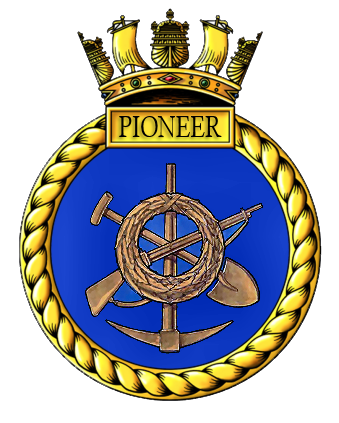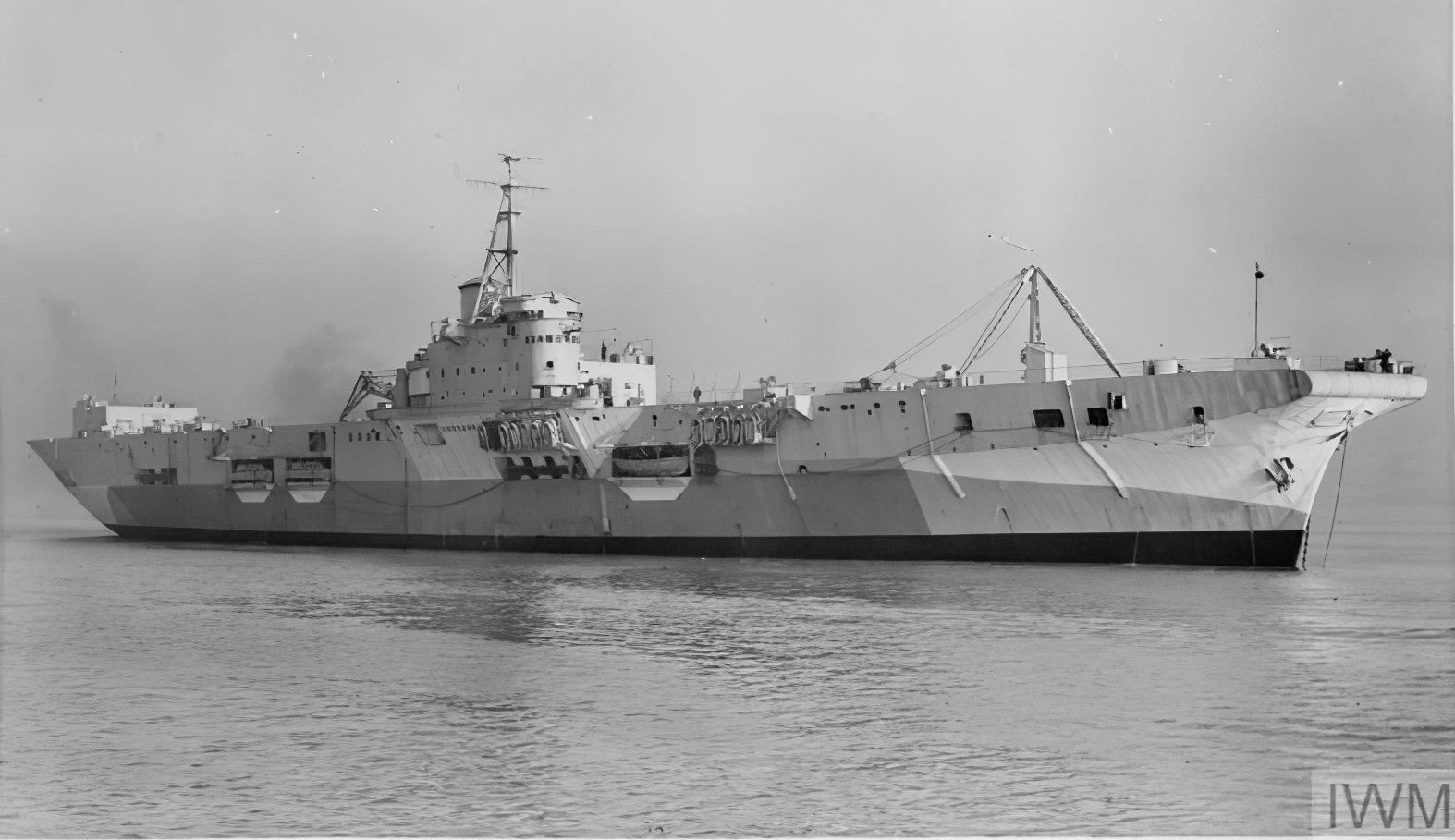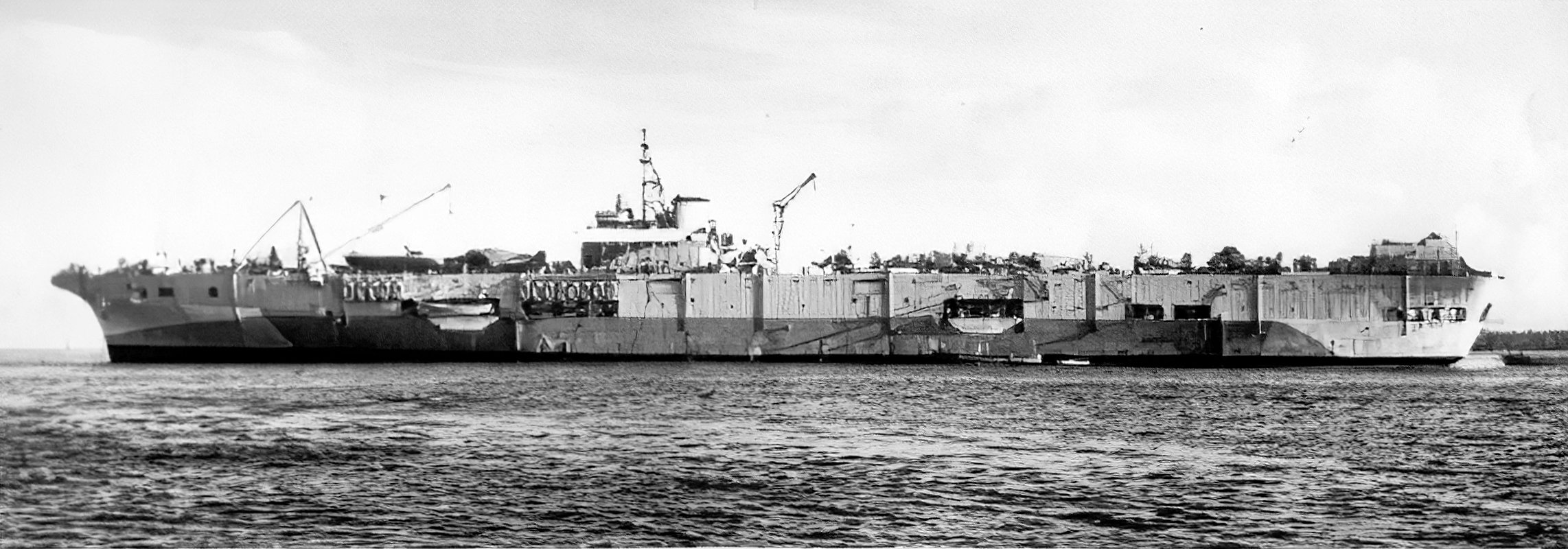Aircraft Maintenance Carrier

Battle Honours
China 1856-60
Specifications
Builder: Vickers Armstrong, (Barrow-in-Furness, United Kingdom
Displacement: 18,330 tons
Length: 695 ft
Beam: 80 ft 4 int
Draught: 23 ft
Speed: 25 Knots
Crew complement: 1,076
Commanding Officers
Captain H. S. Murray-Smith 7 Nov 1944
Captain G. R. Deverell 14 Jan 1946
Lt. Cdr J. D. H. Manly
Cdr G. T. McInnes
Lieutenant W. A. Woolley
Related items
H.M.S. PIONEER
Read aloud

History
Laid down as a Colossus class Light Fleet Aircraft Carrier on December 2nd 1942 at Vickers Armstrong, Barrow-in-Furness she was launched May 20th 1944. Her designation was changed, along with that of her sister ship PERSEUS, to Aircraft Maintenance Carrier while she was being completed. The aft end of her flight deck was obstructed and she was built without catapults so no flying operations could be undertaken; all aircraft had to come aboard from lighters using the ship's cranes.
Originally, she was to be named HMS ETHALION, but was renamed MARS later in 1942; this was changed to PIONEER in July 1944 when the decision was made to repurpose her as an aircraft maintenance carrier. she commissioned at Barrow-in-Furness on January 5th 1945 as HMS PIONEER, Captain H. S. Murray-Smith in command; the tenth ship to bear the name. Her fitting out was completed on February 8th and she commenced her builder’s sea trials.
On completion of her trials and defect rectification at her builder’s yard she proceeded to Rosyth to begin a short work-up in preparation for deployment to join the British Pacific Fleet (BPF). She sailed for Scapa Flow on March 12th, arriving there on the 13th to conduct D/F Calibration. She departed Scapa on the 21st and secured at Belfast on the 22nd to embark air stores, equipment and spare airframes from RN Aircraft Maintenance Yard Belfast for ferrying to Australia.
Allocated to the British Pacific Fleet
PIONEER sailed on her maiden voyage to Sydney, Australia on March 31st 1945 as part of Convoy KMF.42. Leaving the convoy on April 7th at Gibraltar she proceeded to Port Said for passage through the Suez Canal. She made a brief call at Trincomalee before arriving at Sydney in late May. Work began immediately to off-load her ferry load to Royal Naval Air Station Bankstown and prepare her for joining the BPF Fleet Train.
After the first round of operations by the BPF it was apparent that the aviation part of the Fleet Train required a separate organization of its own, so the post of Commodore Air Train (COMAT) and staff were formed with its headquarters in HMS PIONEER. COMAT was responsible, within Rear Admiral Fleet Trains command (RAFT), for the supply of replacement aircraft and spares from the rear base in Australia to the fleet, for aircraft repairs, for replacement of personnel, and the administration of the aircraft repair-and store ships. This supply chain stretched from Sydney to Manus, Manus to Leyte, and from Leyte to the operational area off the Japanese mainland; approximately a 5000-mile trip each way. At the intermediate base in the Admiralty Islands a distance of 2,300 miles from Sydney, a small airstrip on Ponam Island had been loaned by the Americans and was occupied by Mobile Naval Air Base (MONAB) IV in March and this held a small stock of reserve aircraft. This was the furthest forward shore-based aviation support facility when PIONEER arrived in theatre. The supply of replacement aircraft was carried out by escort carriers of the 30th Aircraft Carrier Squadron (30ACS) under Commodore W.P. Carne in STRIKER. PIONEER became the flagship of the Commodore Air Train (COMAT) when Captain H. S. Murray-Smith was promoted to the rank of Commodore 2nd class and hoisted his broad pennant at 0800 on June 10th.
Part of her preparations to sail included embarking the personnel and stores of the newly formed R.N. Forward Aircraft Pool (FAP.) for passage to the intermediate base at Manus in the Admiralty Islands. On completion of loading of the FAP and additional heavy equipment and stores for MONAB IV (HMS NABARON) on Ponam Island, PIONEER sailed from Sydney on June 16th for passage to Manus.
On arrival in the Admiralty Islands on June 21st work commenced to disembark the R.N. FAP to the US Naval Air Station on Pityilu Island where lodger facilities had been secured for its installation. At 0930 On the 25th she arrived off Ponam Island,, 22 miles west, to unload the equipment and stores for the RN Air Station. On return to her anchorage off Pityilu Island she joined the Aircraft Component Repair Ship DEER SOUND which had just arrived back at Manus and the Air Storfe Issue Ship FORT LANGLEY which arrived from Vancouver on July 16th.. The two ships were to work alongside each other to repair aircraft in preparation for a flight test ashore on Pityilu. They were joined by the Aircraft Maintenance Carrier UNICORN on July 21st.
A small test flight had been established on Pityilu in March by UNICORN and PIONEER now disembarked her own flight. Repaired aircraft were craned onto lighters and ferried ashore to Pityilu for their check test flight. Aircraft that completed a successful flight were then taken on charge by theFAP.

Damaged aircraft were transferred from ships in the fleet anchorage, some 3 miles from Pityilu Island, and hoisted aboard. Similarly, repaired aircraft were craned off to be ferried ashore to the jetty at Pityilu. For these transfers PIONEER and UNICORN each carried two 'B' type lighters. Similarly, DEER SOUND carried two large motor lighters, stowed on her forward deck, which were used for conveying plane parts from carriers to the repair ship or to PIONEER and UNICORN. An extra lighter which had been embarked by PIONEER in Sydney needed a lot of refitting and did not come into service until July 19th when it was delivered to Ponam for use by MONAB IV.
One big limitation was the type ‘B’ could only carry a single aircraft so an American ’NL’ pontoon was loaned to help speed up transfers; this could carry up to four planes and could handle the shallow draft and dock at the Pityilu jetty
After the Japanese surrender on August 15th many of the Fleet Train vessels were dispatched to assist in the re-establishment of the recently liberated British Colonies. On August 30th PIONEER and DEER SOUND sailed to join Task Group 111.2 for the re-occupation of Hong Kong. DEER SOUND departed in company with the Oilers GREEN RANGER and RAPIDOL, Salvage vessels SALVESTOR and SALVICTOR, escorted by HMA Ships GAWLER, LAUNCESTON and TAMWORTH; this small convoy arrived off Hong Kong on September 9th 1945. PIONEER sailed for Hong Kong via Subic Bay, also arriving off the Colony on September 9th.
While at Manus, PIONEER repaired 24 aircraft in 8 weeks and, after test flight, transferred them to the R.N. FAP while UNICORN repaired 8 aircraft in the five weeks that she was present, in addition to preparing 18 aircraft for service from Class II preservation.
Hong Kong reconstruction efforts
At Hong Kong the ship’s workshops and engineers were utilised in repairing the colonies infrastructure. The Japanese had sabotaged many systems once the surrender was announced; on reaching the colony Power, water, sanitation, transport and communication systems were all in a bad way. Those men not employed in the repair efforts were assigned to guard duty ashore protecting key sites while preparations were made for the official surrender on September 16th.
On completion of reconstruction work PIONEER was ordered to Sydney, sailing from Hong Kong on November 30th. On passage she was diverted to Torokina, Bougainville to evacuate 250 Australian Imperial Force (AIF) and 20 Royal Australian Air Force (RAAF) personnel, arriving at No. 2 wharf Woolloomooloo at 08.15 on December 15th.
COMAT transferred to PERSEUS
The second Aircraft Maintenance Carrier HMS PERSEUS arrived at Sydney on December 22nd. She acted as a ferry carrier on the outward journey from the UK bringing new Seafire and Firefly aircraft to replace the American types being withdrawn from service with the BPF. There was no requirement for two maintenance carriers so PIONEER was to be replaced by PERSEUS and COMAT Commodore H. S. Murray-Smith transferred his Broad Pennant to her on January 14th. Captain G. R. Deverell, commanding officer of PERSEUS assumed command of PIONEER on this date.
Dumping surplus aircraft at sea
After spending Christmas in Australia preparation began for the ship to undertake a most unusual task, the dumping of surplus aircraft at sea. As the BPF began to reduce in size many naval air squadrons were being disbanded and their aircraft remained in Australia; these were eventually delivered to Royal Naval Air Station Bankstown in Sydney for disposal. The American aircraft were supplied under the ‘Lend-Lease agreement’ between the UK and the US; these aircraft and their support equipment were on loan and once the war was over, they were to be either returned or paid for – any destroyed in combat were written off. In reality the US did not want them back and the British had no use for the majority of them so the solution was to destroy them. Approximately 720 aircraft faced this fate. Some of the planes, only recently uncrated and assembled, have never - been flown in Australia.
Three hundred were to be dumped into the sea off Sydney Heads during the second half of January 1946. PIONEER loaded her first consignment of 70 airframes at Pyrmont on January 17th, the aircraft were transported on trailers from Bankstown through the streets of Sydney to Pyrmont and then hoisted on board. She put to sea the following day and the planes were pushed over the bow in deep water about 20 miles off the coast.
On the 23rd she sailed for Brisbane where she loaded a further 70 aircraft at Brett’s Wharf, Hamilton for dumping on the 26th. These aircraft came from the Royal Naval Aircraft Repair Yard at Archerfield and were also delivered to the ship on specialist trailers or were towed on their own wheels. This consignment included a number of British Fairey Barracuda Torpedo Bombers, a type that was being withdrawn from service.
Arriving back at Sydney on February 3rd she anchored in the harbour to await a spot alongside at Prymont. She secured alongside at 1600 on the 6th for a short period of defect rectification and to begin loading for her return to the UK.
Bullion ship
On Sunday February 17th PIONEER sailed for Melbourne, arriving on the 19th and secured alongside at Station Pier to take on a valuable cargo. 22½tons of gold bullion worth £5,000,000 was loaded for return to Britain. Australia had stored many consignments of bullion for other countries during the war, including the UK and the Netherlands.
PIONEER sailed from Melbourne on February 21st; her ultimate destination was the UK. After a brief call at Fremantle she proceeded to Singapore. It is unclear how long she remained in Singapore but she continued her passage home calling at Port Klang, Malaya in March, and possibly Trncomalee, before entering the Red Sea for the Suez Canal. On arrived in Liverpool her passengers and bullion were unloaded.
Placed in reserve
Shortly after being unloaded PIONEER was transferred to the reserve fleet and command passed to Lt. Cdr J. D. H. Manly, her executive officer. The ship remained manned until at least 1950; Commander G. T. McInnes took over in March 1947 and Lieutenant W. A. Woolley in Nov 1947.
In June 1953 the carrier was reclassified as a ferry carrier and was allocated the pennant number A198. This was probably for service with PERSEUS supplying aircraft to the Aircraft Holding Units (AHU) at RNAS Hal Far, Malta and the AHU at RNAS Sembawang, Singapore during the Korean War. PERSEUS had begun working in the ferry role at the end of 1952 making two round trip voyages to Singapore during 1953 and the addition of PIONEER would allow PERSEUS for more flexibility in the delivery frequency if needed. However, Commonwealth operations off Korea ended on May 4th 1954 and PIONEER was not required; PERSEUS completed her third and final ferry voyage in July 1954.
PIONEER remained in the reserve fleet until she was put up for disposal in 1954 and was sold to Thos. W. Ward ship breakers in September of that year. She was towed to Inverkeithing, Scotland to be broken up for scrap.
Last modified: 23 February 2023
Primary information sources
Additional sources:

Comments (0)